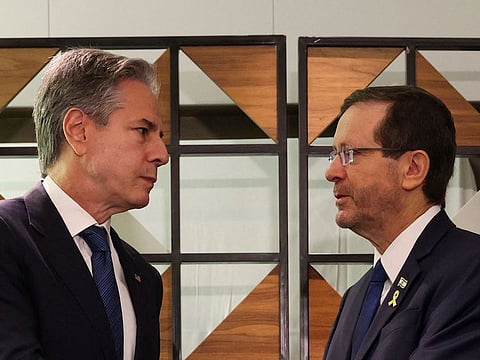Blinken says Gaza talks ‘maybe the last’ chance for truce
Netanyahu's office says meeting with top US diplomat 'positive'

TEL AVIV: Top US diplomat Antony Blinken on Monday urged Israel and Hamas not to derail negotiations that he said may be a “last opportunity” to secure a Gaza truce and hostage release deal.
Blinken, on his ninth regional tour since Hamas’s October 7 attack triggered the war, said he was back in Tel Aviv “to get this agreement to the line and ultimately over the line”.
“This is a decisive moment - probably the best, maybe the last, opportunity to get the hostages home, to get a ceasefire and to put everyone on a better path to enduring peace and security,” Blinken said as he met Israeli President Isaac Herzog.
Later, Benjamin Netanyahu’s three-hour meeting with Blinken was “positive and conducted in a good spirit”, according to a statement from the Israeli prime minister’s office.
“The prime minister reiterated Israel’s commitment to the latest American proposal regarding the release of our hostages — taking into account Israel’s security needs, which he insists on firmly,” Netanyahu’s office said.
Israel and Hamas traded blame for delays in reaching a truce accord, which diplomats say could help avert a wider conflagration in the Middle East.
“We’re working to make sure that there is no escalation, that there are no provocations, that there are no actions that in any way could move us away from getting this deal over the line, or, for that matter, escalating the conflict to other places, and to greater intensity,” Blinken said.
“It is time for it to get done. It’s also time to make sure that no one takes any steps that could derail this process.”
Months of on-off talks with US, Qatari and Egyptian mediators have failed to produce an agreement.
But the stakes have risen since the late July killings of Iran-backed militant leaders, including Hamas political chief Ismail Haniyeh, and as the humanitarian crisis in the besieged Gaza Strip deepened.
Ahead of talks in Qatar last week, Hamas had called on mediators, rather than holding more negotiations, to implement a framework outlined in late May by US President Joe Biden.
Biden said Sunday that a ceasefire was “still possible” and that the United States was “not giving up,” in brief comments to reporters.
Trading blame
After the Qatar meeting, the United States had submitted what mediators called a “bridging proposal”, which Hamas on Sunday said “responds to Netanyahu’s conditions” and includes terms that the Palestinian group would not accept.
Hamas insisted on “a permanent ceasefire and a comprehensive withdrawal from the Gaza Strip”, saying Netanyahu wanted to keep Israeli forces at several strategic locations: Netzarim junction, the Rafah crossing and the Philadelphi corridor.
Netzarim sits between northern and southern Gaza, while Israel sees the Rafah crossing and the Philadelphi corridor, on the Hamas-ruled territory’s border with Egypt, as important for preventing the flow of weapons.
Netanyahu was “fully responsible for thwarting the efforts of the mediators”, the Palestinian movement said in a statement.
Herzog, speaking alongside Blinken, denounced “the refusal of Hamas to move forward”.
The president, who holds a largely ceremonial role, said Israelis wanted to see the return “as soon as possible” of hostages still held in Gaza.
Israeli opposition leader Yair Lapid, in a post on social media platform X, called on Netanyahu to “not miss this opportunity” and “bring them back”.
Western ally Jordan, hostage supporters protesting in Israel, and Hamas itself have called for pressure on Netanyahu in order for an agreement to be reached.
On Sunday Netanyahu reiterated that Hamas “remains obstinate” and must be pressured, a day after his office said Israeli negotiators had expressed “cautious optimism” about reaching a deal.
US, Qatari and Egyptian mediators also reported progress.
Far-right members crucial to the prime minister’s governing coalition oppose any truce.
‘No more space’
The October 7 attack on southern Israel resulted in the deaths of 1,198 people, mostly civilians, according to an AFP tally of Israeli official figures.
Vowing to destroy Hamas, Israel’s military campaign in Gaza has killed at least 40,099 people, according to the territory’s health ministry, which does not give details of civilian and militant deaths.
Out of 251 hostages seized during Hamas’s attack, 111 are still held in Gaza, including 39 the military says are dead. More than 100 were freed during a one-week truce in November.
The plan announced by Biden at the end of May would freeze fighting for an initial six weeks as Israeli hostages are exchanged for Palestinian prisoners in Israeli jails and humanitarian aid enters Gaza.
As efforts towards a long-sought ceasefire continued, so did the violence in Gaza but also along the Israel-Lebanon border where Israeli forces and Hamas’s Iran-backed ally Hezbollah have traded near-daily fire throughout the war.
Hezbollah on Monday claimed attacks on troops and positions in northern Israel, a day after a deadly Israeli strike on south Lebanon’s Tyre.
In southern Gaza, Israeli evacuation orders warning of imminent military action have “reduced the safe zone”, leaving “no more space” for displaced Palestinians, said Samah Dib, 32.
Some “are sleeping on the street”, while clean water is scarce and food is “very expensive and we have no money left”, said Dib, who like almost all of Gaza’s 2.4 million people is among the displaced.
From the Israeli-designated safe zone in southern Gaza’s Al-Mawasi, a fearful Lina Saleha, 44, said she could hear the rumble of tanks “getting closer”.
Sign up for the Daily Briefing
Get the latest news and updates straight to your inbox



